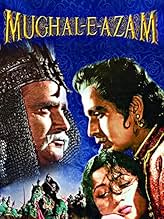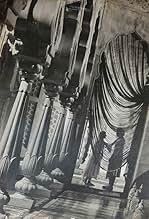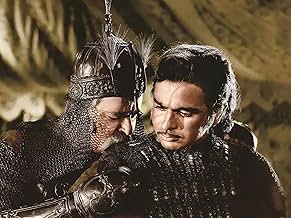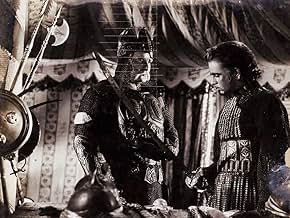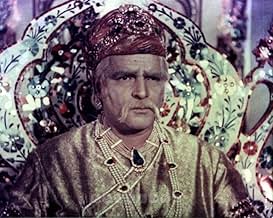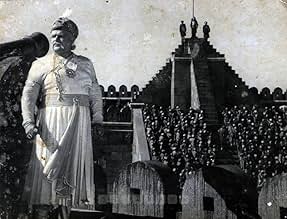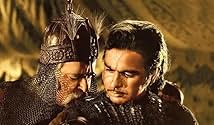IMDb रेटिंग
8.1/10
9.3 हज़ार
आपकी रेटिंग
एक १६वीं सदी के राजकुमार को अपने दरबार की नृत्यकार से प्यार हो जाता है और वह अपने सम्राट पिता के साथ युद्ध करता है.एक १६वीं सदी के राजकुमार को अपने दरबार की नृत्यकार से प्यार हो जाता है और वह अपने सम्राट पिता के साथ युद्ध करता है.एक १६वीं सदी के राजकुमार को अपने दरबार की नृत्यकार से प्यार हो जाता है और वह अपने सम्राट पिता के साथ युद्ध करता है.
- पुरस्कार
- 3 जीत और कुल 3 नामांकन
Prithviraj Kapoor
- Emperor Akbar
- (as Prithviraj)
Ajit Khan
- Durjan Singh
- (as Ajit)
Jillo
- Anarkali's Mother
- (as Jillo Bai)
Sheila Dalaya
- Suraiya
- (as Sheela Delaya)
Tabassum Govil
- A Tawaif
- (as Baby Tabassum)
फ़ीचर्ड समीक्षाएं
I haven't seen the black and white original of Mughal E Azam since the '80's, but I recently saw the restored revived colourised 2004 re-release for the first time and was astounded by the results. I'm not a believer in messing around with the originals, but bearing in mind director Asif always wanted to make the whole film in colour but didn't have enough money the "final" product is amazing to see - such is technology! It was incredibly expensive to make as it was, the restoration process must have cost a fabulous amount too.
Seminal Indian epic purporting to deal with events from about 400 years ago around Prince Saleem (Dilip Kumar) falling in love with a court dancer Anarkali (Madhubala) to his father Akbar's utter opposition and eventually causing a rift leading to all out war. The drama and war spectacle scenes are memorable enough, with thousands of humans and animals as extras, and the music is uniformly superb too. But it's Pyar Kiya To Darna Kya (If I have loved someone>why should I be afraid?) sung by Anarkali (Lata) to the 2 of them in the Hall Of Mirrors that is absolutely stunning - I will have to get the original and compare, because the remaster seems to have turned this song into something even more magical and mesmerising than I remembered. It took Naushad and Shakeel Badayuni one night to compose music and lyrics so timeless - a colourful piece of poetry in motion, with the insistent kaleidoscopic climax added by Asif. Awesome! According to the legend it was supposed to have an unhappy ending - needless to say I'm glad it was altered here to a happy one after such a roller-coaster ride!
A tremendous work of Art, showing the very best of Indian cinema.
Seminal Indian epic purporting to deal with events from about 400 years ago around Prince Saleem (Dilip Kumar) falling in love with a court dancer Anarkali (Madhubala) to his father Akbar's utter opposition and eventually causing a rift leading to all out war. The drama and war spectacle scenes are memorable enough, with thousands of humans and animals as extras, and the music is uniformly superb too. But it's Pyar Kiya To Darna Kya (If I have loved someone>why should I be afraid?) sung by Anarkali (Lata) to the 2 of them in the Hall Of Mirrors that is absolutely stunning - I will have to get the original and compare, because the remaster seems to have turned this song into something even more magical and mesmerising than I remembered. It took Naushad and Shakeel Badayuni one night to compose music and lyrics so timeless - a colourful piece of poetry in motion, with the insistent kaleidoscopic climax added by Asif. Awesome! According to the legend it was supposed to have an unhappy ending - needless to say I'm glad it was altered here to a happy one after such a roller-coaster ride!
A tremendous work of Art, showing the very best of Indian cinema.
K. Asif was the Indian "Cecille B. Demille" (who was known as CB, in the industry)conceived and executed his vision on a grand Scale. There will only be one "Ben-Hur", one "Lawrence of Arabia", one "Sound of Music", one "Sangam", one "Gadar-Ek Prem Katha" and only one "Mughal-E-Azam". The grand scale is evident in the lyrical poetry set into music by music maestro Naushad, which laid the rich tapestry for this Magnum Opus. Prithviraj Kapoor, was the doyen, who started Prithvi theaters and was the patriarc of the Kapoor Clan, which included The older Raj Kapoor, Shammi Kapoor, and Sashi Kapoor. The most talented was Raj kapoor, who was the "Barnum" of the Indian Cinema. He made countless movies and everyone of them a masterpiece, but the best was "Sangam" (1963). Baritone voiced Prithviraj Kapoor, was in the same genre as Charlston Heston,Laurence Olivier and Richard Burton, an actor's actor; a style that was unique and patented. After I watched the movie after three decades, few things stood out-the ornate settings for the Madhubala's (Born as Mumtaz Begum, was married to singer/actor Kishore Kumar, and died at age of 36, from a congenital heart problem), dance sequence, the rich music, the beauty of the yesteryear actresses and the devotion of the directors to make a statement-not just a movie. For current tastes and standards("Dabaang" "Three Idiots" "Housefull 2" produced by the Bollywood suvvar scum maggots,) the movie is a drag, but for the masses in the bygone years that starved for class and elegance, this was a treat. I was not too impressed with Dilip Kumar, as young Prince, most of the time he looked distant and lost. Suffice to say he matured to be good actor ("Ram aur Shyam") in the later years. The two that carried the mantle were Kapoor and Madhubala.
Mughul-E-Azam boasts of some of the highest production values employed in filmmaking in India up to that point, and the result is astounding, to say the least. The film is a true cinematic experience in terms of aesthetics, and be it the black-and-white or the colour version, it is an unforgettable visual treat. The sets, the costumes, are stunningly lavish, almost to the point of casting a gloom over the story itself. And then we have the story, an epic, poetic one, which involves a most subtle love story. The dialogue is stupendous, with many lines having a memorable, larger-than-life quality which enhances the narrative beyond imagination. The music is similarly fantastic, with spectacularly performed dance numbers. Needless to say, "Pyar Kiya To Darna Kya" is the high-point of the film and the story it tells. Prithviraj Kapoor is excellent in a wonderfully dramatic and appropriately theatrical performance as Emperor Akbar. Dilip Kumar seems to enjoy his own, mere presence, while underplaying his role to great effect. It is Madhubala, however, who walks away with the most fully-realised part of Anarkali, a slave girl whose dignity cannot be taken away at any cost. I found the film a greatly entertaining watch, and while I had a problem with its overlong running time, as well as some faulty sequences, such as the less convincing battle between the father and son, Mughul-E-Azam remains a meticulous piece of art, and a rightly-touted all-time classic of Indian cinema.
10veeru
Haha -- when I see comments that put Kuch Kuch Hota Hain or any other formulaic hindi flick as "the best film ever" they obviously didn't see K. Asif's vision of Mughal-e-Azam. From Prithviraj Kapoor's magnificent rendering of the imposing Emperor Akbar to Dalip Kumar's obvious love for the spectacular Madhubhala. The exquisite Urdu dialogues is of course not for the neophyte. But for those that can appreciate the finer things in life -- not some cloying Hum Apke Hain Kaun or Shah Rukh Khan's obsession with bleeding and overacting in every single film -- Mughal-e-Azam fits the bill perfectly.
When one thinks of great movies they remember the classics such as gone with the wind, Ben hur etc... but let us not forget one of the greatest cinematic triumphs of Hindi Cinema Mughal-e-Azam a film set in the times of the great Moughul Empire. Having seen both the part B/W and Colour and the remastered full colour version I can truly say that the colourised version truly brings out the true glory of this amazing classic putting it in a league way beyond the Classics of today. The dialogue is simply superb and the acting truly amazing modern filmmakers could learn thing or two about acting. The cinematography is simply stunning for a movie of its time. the grandeur and opulence of the sets really comes out in full colour. The story though not very relevant for modern times shows the views and attitudes of India's past. a truly great film to watch...
क्या आपको पता है
- ट्रिवियाThe song "Pyar Kiya To Darna Kiya" has an unusual history to it: it cost Rs. 10 million at a time when a film would be made for less than a million; it was written and re-written 105 times by the lyricist, Shakeel Badayuni, before the music director, Naushad, could approve of it; it was shot in the renowned Sheesh Mahal (Palace of Mirrors); and in those days of sound recording, editing and mixing, as there was no way to provide the reverberation of sound, Naushad had playback singer Lata Mangeshkar sing the song in a studio bathroom.
- गूफ़Music and dancing styles from the 19th century were depicted, although the story takes place in the 16th century. For example, Thumri, a semi-classical music form developed in the 19th century, is adopted in a dance sequence in Kathak style, which is a 16th-century dance form.
- क्रेज़ी क्रेडिट2004: The End Credits play the song 'Pyaar Kiya To Darna Kya' and its 1960 end credits are adjacent to the 2004 (Technicians) credits.
- इसके अलावा अन्य वर्जनThe original version is in B/W and only one song 'Pyar kiya to darna kya...' was shot in color as most of the film (by the time color technology was available) was complete. This was at the end of almost 10 years that the film was being completed. However, the year 2004 re-release is re-mastered from the original B/W version to Color with Dolby Digital sound and some visual enhancements.
- कनेक्शनFeatured in Century of Cinema: And the Show Goes On: Indian Chapter (1996)
टॉप पसंद
रेटिंग देने के लिए साइन-इन करें और वैयक्तिकृत सुझावों के लिए वॉचलिस्ट करें
- How long is Mughal-E-Azam?Alexa द्वारा संचालित
विवरण
- रिलीज़ की तारीख़
- कंट्री ऑफ़ ओरिजिन
- आधिकारिक साइट
- भाषाएं
- इस रूप में भी जाना जाता है
- The Great Mughal
- उत्पादन कंपनी
- IMDbPro पर और कंपनी क्रेडिट देखें
बॉक्स ऑफ़िस
- बजट
- ₹1,50,00,000(अनुमानित)
- US और कनाडा में सकल
- $1,61,434
- US और कनाडा में पहले सप्ताह में कुल कमाई
- $60,258
- 3 अप्रैल 2005
- दुनिया भर में सकल
- $1,61,434
- चलने की अवधि
- 3 घं 17 मि(197 min)
- रंग
- ध्वनि मिश्रण
- पक्ष अनुपात
- 1.37 : 1
इस पेज में योगदान दें
किसी बदलाव का सुझाव दें या अनुपलब्ध कॉन्टेंट जोड़ें


